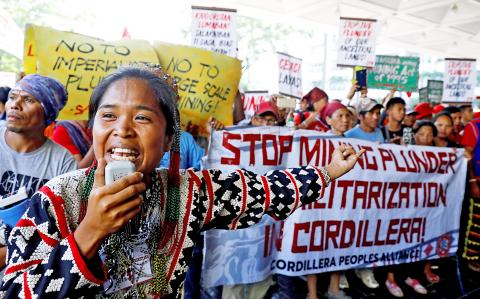About 300 protesters yesterday clashed with security at Manila’s Sofitel Philippine Plaza hotel where an annual mining conference was being held, demanding that mineral extraction be halted due to the environmental destruction caused.
The rally came a day after Philippine President Rodrigo Duterte declared he supported a ban on open-pit mining in the Southeast Asian nation, a move that could constrict supply from the world’s top nickel ore exporters.
“Words are not enough, he must act on it,” said lawyer Aaron Pedrosa of Sanlakas (One Force), an activist political group that was among the protesters. “We are here to express our opposition to mining in our country and the failure of mining companies to rehabilitate mining areas.”

Photo: Reuters
Anti-mining protests are a fixture at mining industry events in the Philippines. Some of the protesters, clad in business suits, managed to get past hotel security and into the lobby, where they held up placards denouncing mining.
Outside the hotel, other protesters, including those from indigenous communities, chanted and held streamers reading “stop mining plunder” and “no to large-scale mining.” The hotel was locked down for at least an hour.
Mining is a contentious issue in the largely underexplored Philippines, following past examples of environmental mismanagement.
In 1996, a tailings leak at Canadian-owned Marcopper Mining Corp’s copper mine in Marinduque contaminated rivers.
The sector contributes less than 1 percent to the economy and only 3 percent of the 9 million hectares the state has identified as having high mineral reserves are being mined, government data show.
Last month, lawmakers allied with Duterte filed a bill seeking to ban mining in watershed areas, as well as exports of unprocessed ores. The bill would also require miners to get legislative approval before operating.
The move came after a 10-month mining crackdown led by former interim Philippine Secretary of Environment and Natural Resources Regina Lopez, who ordered the closure or suspension of 26 of the country’s 41 mines and banned open-pit mining.
Lopez failed to be confirmed in her post by lawmakers and was in May replaced by Roy Cimatu, a former soldier who has so far not reversed any of her previous measures.
Gerard Brimo, president of Nickel Asia Corp, one of the Philippine’s largest nickel ore producers, said the industry would like to show Duterte old mines that have been rehabilitated, including open pits.
Open-pit extraction is allowed under Philippine mining law and is widely used, as most ore is near the surface and low-grade.
“If you want minerals and metals ... that’s the reality. That’s the case in the Philippines as it is all over the world. But the other reality is that it can be rehabilitated,” Brimo said.

Former Nicaraguan president Violeta Chamorro, who brought peace to Nicaragua after years of war and was the first woman elected president in the Americas, died on Saturday at the age of 95, her family said. Chamorro, who ruled the poor Central American country from 1990 to 1997, “died in peace, surrounded by the affection and love of her children,” said a statement issued by her four children. As president, Chamorro ended a civil war that had raged for much of the 1980s as US-backed rebels known as the “Contras” fought the leftist Sandinista government. That conflict made Nicaragua one of

COMPETITION: The US and Russia make up about 90 percent of the world stockpile and are adding new versions, while China’s nuclear force is steadily rising, SIPRI said Most of the world’s nuclear-armed states continued to modernize their arsenals last year, setting the stage for a new nuclear arms race, the Stockholm International Peace Research Institute (SIPRI) said yesterday. Nuclear powers including the US and Russia — which account for about 90 percent of the world’s stockpile — had spent time last year “upgrading existing weapons and adding newer versions,” researchers said. Since the end of the Cold War, old warheads have generally been dismantled quicker than new ones have been deployed, resulting in a decrease in the overall number of warheads. However, SIPRI said that the trend was likely

BOMBARDMENT: Moscow sent more than 440 drones and 32 missiles, Volodymyr Zelenskiy said, in ‘one of the most terrifying strikes’ on the capital in recent months A nighttime Russian missile and drone bombardment of Ukraine killed at least 15 people and injured 116 while they slept in their homes, local officials said yesterday, with the main barrage centering on the capital, Kyiv. Kyiv City Military Administration head Tymur Tkachenko said 14 people were killed and 99 were injured as explosions echoed across the city for hours during the night. The bombardment demolished a nine-story residential building, destroying dozens of apartments. Emergency workers were at the scene to rescue people from under the rubble. Russia flung more than 440 drones and 32 missiles at Ukraine, Ukrainian President Volodymyr Zelenskiy

Indonesia’s Mount Lewotobi Laki-Laki yesterday erupted again with giant ash and smoke plumes after forcing evacuations of villages and flight cancelations, including to and from the resort island of Bali. Several eruptions sent ash up to 5km into the sky on Tuesday evening to yesterday afternoon. An eruption on Tuesday afternoon sent thick, gray clouds 10km into the sky that expanded into a mushroom-shaped ash cloud visible as much as 150km kilometers away. The eruption alert was raised on Tuesday to the highest level and the danger zone where people are recommended to leave was expanded to 8km from the crater. Officers also